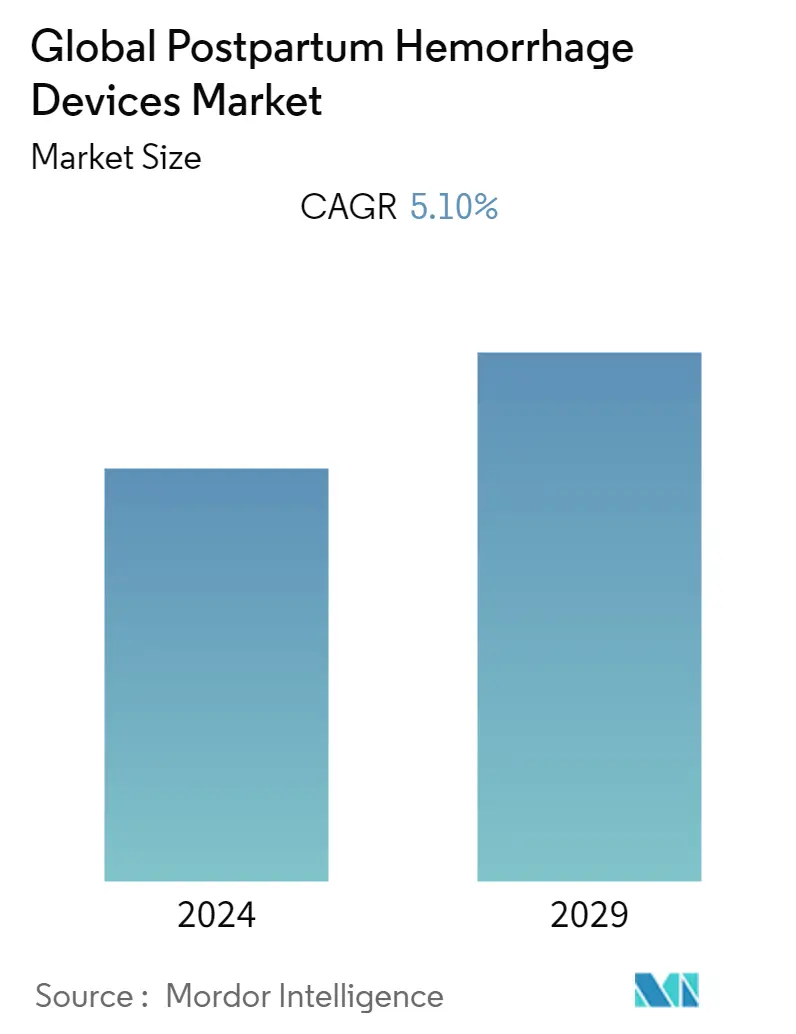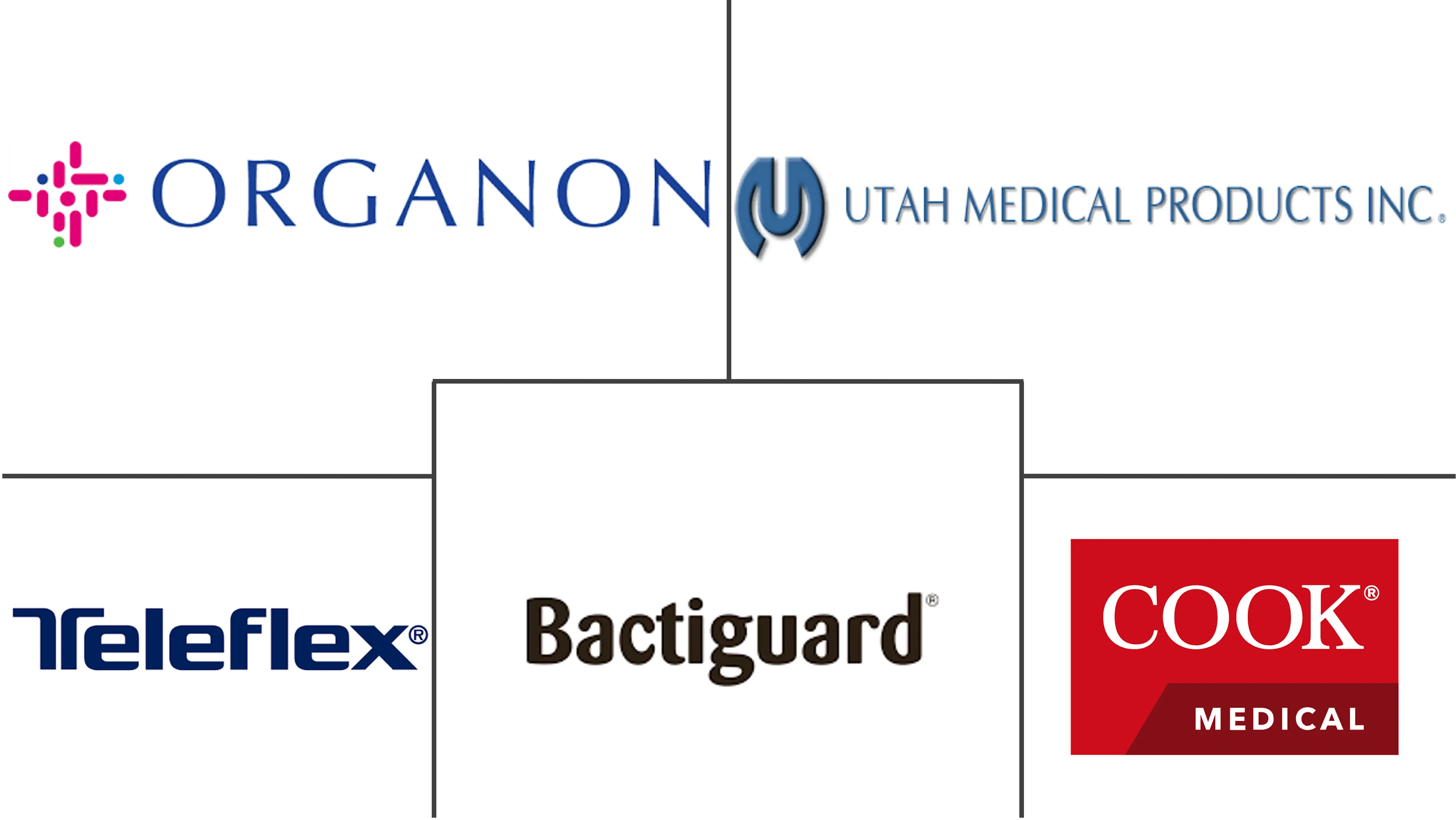Market Size of Global Postpartum Hemorrhage Devices Industry

| Study Period | 2019 - 2029 |
| Base Year For Estimation | 2023 |
| CAGR | 5.10 % |
| Fastest Growing Market | Asia-Pacific |
| Largest Market | North America |
| Market Concentration | Medium |
Major Players
*Disclaimer: Major Players sorted in no particular order |
Postpartum Hemorrhage Devices Market Analysis
The postpartum hemorrhage devices market is expected to register a CAGR of 5.1% over the forecast period (2022-2027).
The COVID-19 pandemic significantly impacted the market for postpartum hemorrhage devices at the beginning. The American College of Obstetricians and Gynaecologists 2022 reports that pregnant women who have COVID-19 and show symptoms are more likely than nonpregnant women with COVID-19 symptoms to require intensive care, require a ventilator (for breathing support), or die as a result of the illness. Despite this, pregnant women's overall risk of serious disease and death is minimal. The COVID-19 outbreak affected the market's growth adversely in its preliminary phase; however, the number of pregnancy complications has increased, and so has the demand for postpartum hemorrhage devices to treat patients and save the lives of mothers, assisting in the advancement of the industry.
Further, the increasing rate of complications in pregnancies is a major factor driving the demand for postpartum hemorrhage devices, thereby contributing to market growth. The 2021 bulletin published in the journal of Obstetrics and Gynecology explains the atrocities of anemia during pregnancy. Iron deficiency and abrupt blood loss are the two most common causes of anemia during pregnancy and puerperium. During pregnancy, iron requirements rise, and failing to maintain adequate iron levels can have negative maternal-fetal implications. Such factors will likely boost the adoption of postpartum hemorrhage devices, thereby contributing to market growth.
Moreover, market players are involved in marketing strategies like mergers and acquisitions of products launched. For instance, in 2021, Merck announced the acquisition of Alydia Health on behalf of its planned spinoff of Organon, which implements dedication to enhancing women's health through addressing unmet medical needs in maternal health by facilitating safer delivery. The Jada System, Alydia's technology, is designed to induce natural uterine contractions to prevent excessive bleeding after childbirth. The United States Food and Drug Administration granted Alydia 510(k) clearance (marketing authorization) for the Jada System in August 2020, based on the company's pivotal PEARLE IDE Study results. The Global Health Investment Fund and AXA IM Alts, through its Impact Investing Strategy, are Alydia's lead institutional investors. They are social impact funds that invest in innovative technologies that can generate attractive financial returns while helping address major public health issues worldwide. Additionally, in September 2021, Stryker announced the acquisition of Gauss Surgical, a medical device firm that created TritonTM, an artificial intelligence-powered platform for real-time blood loss monitoring during surgery. Triton has shown advantages in maternity and surgical care by detecting hemorrhage earlier and intervening sooner.
Furthermore, prominent market competitors favorably impact the industry's growth through new product releases and strategic efforts by prominent market competitors. For example, in March 2022 Baymatob's wearable devices completed capital rise to advance life-saving labor monitoring devices. Baymatob's wearable device Oli uses innovative sensor technology and AI interpretation to detect a Pending PPH during labor before postpartum bleeding starts.
Therefore, owing to the aforementioned factors, the studied market is anticipated to witness growth over the analysis period. However, the lack of trained professionals restrains the postpartum hemorrhage market growth.
Postpartum Hemorrhage Devices Industry Segmentation
As per the scope of the report, Postpartum hemorrhage devices are a type of treatment device when there is significant vaginal bleeding that occurs after a baby is born. Postpartum hemorrhage is a dangerous illness that can result in death. Dizziness, faintness, and blurred vision are further symptoms of postpartum bleeding. Postpartum hemorrhage can develop after delivery or up to 12 weeks after giving birth. Early detection and prompt treatment with proper devices can lead to a full recovery. The postpartum hemorrhage devices market is segmented by Product Type (Non-Pneumatic Anti-Shock Garment, Prefilled Injection System, Uterine Tamponade Devices), End Users (Hospitals, Clinics & Other End Users), Geography (North America, Europe, Asia-Pacific, Middle East and Africa and South Africa). The market report also covers the estimated market sizes and trends for 17 different countries across major regions, globally. The report offers the value (in USD million) for the above segments.
| By Product Type | |
| Non-Pneumatic Anti-Shock Garment | |
| Prefilled Injection System | |
| Uterine Tamponade Devices |
| By End User | |
| Hospitals | |
| Clinics | |
| Other End Users |
| Geography | ||||||||
| ||||||||
| ||||||||
| ||||||||
| ||||||||
|
Global Postpartum Hemorrhage Devices Market Size Summary
The postpartum hemorrhage devices market is poised for growth, driven by an increasing incidence of pregnancy complications and the rising demand for effective treatment solutions. The market experienced initial setbacks due to the COVID-19 pandemic, which highlighted the vulnerabilities of pregnant women with COVID-19 symptoms. However, the subsequent rise in pregnancy-related complications has spurred demand for postpartum hemorrhage devices, contributing to market expansion. Key factors such as anemia during pregnancy, driven by iron deficiency and blood loss, have further propelled the adoption of these devices. The market is also witnessing strategic activities like mergers and acquisitions, with companies such as Merck and Stryker enhancing their portfolios to address maternal health needs. Innovations like the Jada System and TritonTM are setting new standards in postpartum care, with regulatory approvals bolstering their market presence.
The uterine tamponade segment is expected to see significant growth due to its non-invasive and cost-effective nature, particularly in developing regions. Advances in vacuum-induced devices and studies supporting the use of condom tamponade are enhancing the appeal of these products. North America leads the market, driven by high maternal mortality rates and advancements in healthcare infrastructure. The region's growth is supported by increased healthcare spending and awareness of sophisticated treatment options. The market's competitive landscape is fragmented, with numerous global and regional players like Bactiguard and Teleflex Incorporated. Initiatives by organizations such as FIGO and the International Confederation of Midwives are further supporting the development of clinical protocols, aiding in the market's expansion.
Global Postpartum Hemorrhage Devices Market Size - Table of Contents
-
1. MARKET DYNAMICS
-
1.1 Market Overview
-
1.2 Market Drivers
-
1.2.1 Increasing Occurrence of Conditions like Placental Abruption, Multiple Pregnancy and Inverted Uterus and other pregnancy complications (Anemia)
-
1.2.2 Inflated Number of Government Initiatives Coupled with Increased Awareness
-
-
1.3 Market Restraints
-
1.3.1 High Cost of PPH Devices & Lack of Trained Proffesionals
-
-
1.4 Porter's Five Forces Analysis
-
1.4.1 Threat of New Entrants
-
1.4.2 Bargaining Power of Buyers/Consumers
-
1.4.3 Bargaining Power of Suppliers
-
1.4.4 Threat of Substitute Products
-
1.4.5 Intensity of Competitive Rivalry
-
-
-
2. MARKET SEGMENTATION (Market Size by Value - USD million)
-
2.1 By Product Type
-
2.1.1 Non-Pneumatic Anti-Shock Garment
-
2.1.2 Prefilled Injection System
-
2.1.3 Uterine Tamponade Devices
-
-
2.2 By End User
-
2.2.1 Hospitals
-
2.2.2 Clinics
-
2.2.3 Other End Users
-
-
2.3 Geography
-
2.3.1 North America
-
2.3.1.1 United States
-
2.3.1.2 Canada
-
2.3.1.3 Mexico
-
-
2.3.2 Europe
-
2.3.2.1 Germany
-
2.3.2.2 United Kingdom
-
2.3.2.3 France
-
2.3.2.4 Italy
-
2.3.2.5 Spain
-
2.3.2.6 Rest of Europe
-
-
2.3.3 Asia-Pacific
-
2.3.3.1 China
-
2.3.3.2 Japan
-
2.3.3.3 India
-
2.3.3.4 Australia
-
2.3.3.5 South Korea
-
2.3.3.6 Rest of Asia-Pacific
-
-
2.3.4 Middle-East and Africa
-
2.3.4.1 GCC
-
2.3.4.2 South Africa
-
2.3.4.3 Rest of Middle-East and Africa
-
-
2.3.5 South America
-
2.3.5.1 Brazil
-
2.3.5.2 Argentina
-
2.3.5.3 Rest of South America
-
-
-
Global Postpartum Hemorrhage Devices Market Size FAQs
What is the current Global Postpartum Hemorrhage Devices Market size?
The Global Postpartum Hemorrhage Devices Market is projected to register a CAGR of 5.10% during the forecast period (2024-2029)
Who are the key players in Global Postpartum Hemorrhage Devices Market?
Bactiguard, Cook Medical, Utah Medical Products, Inc., Teleflex Incorporated and Organon & Co. are the major companies operating in the Global Postpartum Hemorrhage Devices Market.

